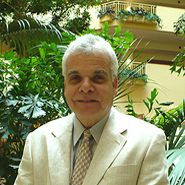|
About Birth
Early Clamping Of
The Umbilical Cord
May Interrupt Humankind's First 'Natural Stem Cell Transplant'

Dr. Paul
Sanberg - University of South Florida Health
May 25, 2010
The
timing of umbilical cord clamping at birth should be delayed just a
few minutes longer, suggest researchers at the University of South
Florida's Center of Excellence for Aging and Brain Repair.
Delaying clamping the umbilical cord for a slightly longer period of
time allows more umbilical cord blood volume to transfer from mother
to infant and, with that critical period extended, many good
physiological "gifts" are transferred through 'nature's first stem
cell transplant' occurring at birth.
The USF review is published in a recent issue of the Journal of
Cellular and Molecular Medicine (14:3).
"Several clinical studies have shown that delaying clamping the
umbilical cord not only allows more blood to be transferred but
helps prevent anemia as well," said the paper's lead author Dr. Paul
Sanberg, director of the Center. "Cord blood also contains many
valuable stem cells, making this transfer of stem cells a process
that might be considered 'the original stem cell transplant'."
At birth, the placenta and umbilical cord start contracting and
pumping blood toward the newborn. After the blood equilibrates, the
cord's pulse ceases and blood flow from mother to newborn stops. In
recent Western medical practice, early clamping - from 30 seconds to
one minute after birth -- remains the most common practice among
obstetricians and midwives, perhaps because the benefits of delaying
clamping have not been clear. However, waiting for more than a
minute, or until the cord stops pulsating, may be beneficial, the
authors said.
Birthing methods have also changed over the last century. Throughout
human history and currently in cultures and areas where delivering
mothers squat to deliver, gravity helps speed the stem cell
transfer. Today, the cord may be clamped early for a number of
reasons, including the medical resuscitation and stabilizing of
infants or the notion that delaying clamping might lead to adverse
effects or, more recently, to quickly facilitate umbilical cord
banking.
According to study co-author Dr. Dong-Hyuk Park, the relationship
between cord clamping time and the transfer of stem cells needs to
be understood through the early weeks of the perinatal period and
the process of 'hematopoiesis,' the formation of blood cells that
begins as early as two weeks into pregnancy. A transfer of pluripotent stems cells continues throughout pregnancy, however, and
for a time through the umbilical cord following delivery.
"Several randomized, controlled trials, systematic reviews and
meta-analyses have compared the effects of late versus early cord
clamping," said Dr. Park. "In pre-term infants, delaying clamping
the cord for at least 30 seconds reduced incidences of intraventricular hemorrhage, late on-set sepsis, anemia, and
decreased the need for blood transfusions."
Another potential benefit of delayed cord clamping is to ensure that
the baby can receive the complete retinue of clotting factors.
Yet, there is debate and disagreement on early versus later
clamping. The side favoring delayed clamping, the authors noted,
cite the value of the infant's receiving umbilical cord blood (UCB)-derived
stem cells, known to be pluripotent.
"The virtue of the unique and immature features of cord blood,
including their ability to differentiate, are well known," added Dr.
Sanberg.
The researchers concluded that many common disorders in newborns
related to the immaturity of organ systems may receive benefits from
delayed clamping. These may include: respiratory distress; anemia;
sepsis; intraventricular haemorrhage; and periventricular
leukomalacia. They also speculate that other health problems, such
as chronic lung disease, prematurity apneas and retinopathy of
prematurity, may also be affected by a delay in cord blood clamping.
"There remains no consensus among scientists and clinicians on cord
clamping and proper cord blood collection," concluded co-author and
obstetrician Dr. Stephen Klasko, senior vice president of USF Health
and dean of the USF College of Medicine. "The most important thing
is to avoid losing valuable stems cells during and just after
delivery."
The authors agreed that delaying cord clamping should appropriately
be delayed for pre-term babies and babies born where there is no
effort to bank umbilical cords, and for babies born where there is
limited access to health care and where nutrition may be poor.
View
Article in
Medical
News Today

Dr. Paul
Sanberg
Dr. Paul
R. Sanberg is Distinguished University Professor and Director of the
Center of Excellence for Aging and Brain Repair and Associate Vice
President/Associate Dean for Biotechnology Development at the
University Of South Florida College Of Medicine. Dr. Sanberg trained
at York University, the University of British Columbia, the
Australian National University and at the Johns Hopkins University
School of Medicine. Dr. Sanberg has held academic positions at the
Ohio University, the University of Cincinnati, and Brown University
prior to his current position. He has also been on the Scientific
Advisory Boards for Companies and Foundations. Dr. Sanberg is
Editor-in-Chief of Cell Transplantation, Executive Director of the
American Society for Neural Transplantation and Repair, and past
president of the Cell Transplant Society, and others. He is the
author of more than 400 scientific articles and has published
thirteen books including, Neural Stem Cells: Methods and Protocols
(Humana Press, 2002), and Neural Stem Cells for Brain and Spinal
Cord Repair (Humana Press, 2003) and is an inventor on over twenty
U.S. patents. His work is pioneering in understanding a role for
stem cells in neurological disorders.
|


